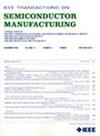在高温 SPM 工艺中通过 300 毫米单晶片室中的氮气吹扫消除晶圆表面的 Si-C 缺陷
IF 2.3
3区 工程技术
Q2 ENGINEERING, ELECTRICAL & ELECTRONIC
引用次数: 0
摘要
在半导体制造过程中,高温过氧化硫酸混合物(SPM)和空气中的分子污染物(AMC)会在晶片表面形成碳化硅(Si-C)等缺陷。此外,缺陷还会对设备性能、产量和生产效率产生不利影响。在这项工作中,我们提出了一种新方法,即在单晶圆腔内引入一个额外的氮气(N2)吹扫喷嘴,以减少总挥发性有机化合物(t-VOC)。此外,我们还深入探讨了 SPM 中缺陷形成的内在机理,而这一机理此前尚未得到解释。在 SPM 过程中,缺陷是由 AMC 和高温形成的。因此,本研究对各种 AMC 进行了研究。此外,还分析了 Si-C 缺陷数量与温度和化学流动持续时间的相关性。实验结果表明,缺陷和 t-VOC 遵循相同的浓度趋势。我们的氮气吹扫方法有效地稀释了腔室环境,降低了污染颗粒与晶片表面之间的附着能量。单晶圆室内合适的氮气吹扫率有助于消除晶圆表面约 63% 的缺陷。因此,这种方法对于最大限度地减少 Si-C 缺陷和改善高温 SPM 湿式清洁工艺的腔室环境至关重要。本文章由计算机程序翻译,如有差异,请以英文原文为准。
Elimination of Si-C Defect on Wafer Surface in High-Temperature SPM Process Through Nitrogen Purge in 300-mm Single-Wafer Chamber
During semiconductor manufacturing, the high temperature sulfuric acid peroxide mixture (SPM) and airborne molecule contaminants (AMCs) can result in the formation of defects such as Silicon-carbide (Si-C) on the wafer surface. Furthermore, defects adversely affect device performance, yield, and manufacturing productivity. In this work, a novel approach is proposed by introducing an additional nitrogen (N2) gas purge nozzle inside the single wafer chamber to reduce total volatile organic compounds (t-VOC). Additionally, we provide insights into the mechanism underlying defect formation in SPM which has not been previously explained. In SPM process, defects are formed by AMCs and high temperature. So, various AMCs were investigated in this work. Moreover, the correlation of the number of Si-C defect with temperature and duration of chemical flow was also analyzed. The experimental results demonstrated that defects and t-VOC follow the same concentration trend. Our nitrogen purge method effectively diluted the chamber environment, reducing the adhesion energy between contamination particles and the wafer surface. A suitable N2 purging rate inside the single-wafer chamber facilitated the elimination of around 63% of defects from wafer surface. Hence, this approach can be crucial in minimizing the Si-C defects and improving the chamber environment for high-temperature SPM wet-cleaning process.
求助全文
通过发布文献求助,成功后即可免费获取论文全文。
去求助
来源期刊

IEEE Transactions on Semiconductor Manufacturing
工程技术-工程:电子与电气
CiteScore
5.20
自引率
11.10%
发文量
101
审稿时长
3.3 months
期刊介绍:
The IEEE Transactions on Semiconductor Manufacturing addresses the challenging problems of manufacturing complex microelectronic components, especially very large scale integrated circuits (VLSI). Manufacturing these products requires precision micropatterning, precise control of materials properties, ultraclean work environments, and complex interactions of chemical, physical, electrical and mechanical processes.
 求助内容:
求助内容: 应助结果提醒方式:
应助结果提醒方式:


